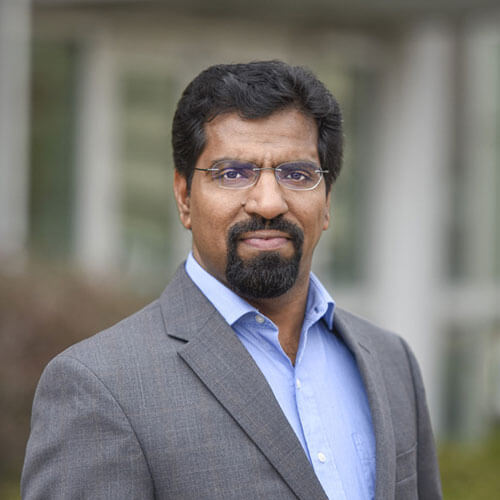An interdisciplinary team of researchers at UAB has developed a new plasma-enabled process that could limit the proliferation of toxins from implants into a patient’s bloodstream. The team, led by Vinoy Thomas, Ph.D., associate professor in the Department of Mechanical and Materials Engineering (MME), recently published its findings in ACS Applied Materials & Interfaces.
In the article, the authors explain that a major challenge of developing nanoparticle-modified biomedical implant material is to stably attach metallic nanoparticles on different surfaces—particularly polymer surfaces. “For years, scientists have achieved synthesis of metallic nanoparticles in aqueous solutions using both chemical and biological (plant extracts) reducing agents,” Thomas said. “The challenge of attaching metallic nanoparticles is especially difficult in cases involving hydrophobic polymeric biomaterials, which most polymeric biomaterials fall under.”
To address this challenge, Thomas and his team developed a plasma-enabled process they termed “Plasma Electroless Reduction” (PER). The PER process allows researchers to deposit gold and silver nanostructures on different 2D and 3D polymer material surfaces, such as cellulose paper, polypropylene-based facemasks and 3D printed polymer scaffolds.
“It is well known that there are toxicity issues offered by the rapid and premature release of the metallic nanostructures from the implant material into the blood stream,” Thomas said. “This issue could only be addressed by ensuring the stable anchoring of the metallic nanostructures on implant surfaces. This has inspired us to optimize our PER process by conducting systematic and in-depth investigation of concentration of the metallic precursor followed by sonication wash before cell culture in vitro.”
In Thomas’s study, his team was able to successfully anchor silver nanoparticles on the surface of 3D printed polymers without any rapid release into the surroundings. The team’s additive manufacturing expertise also allowed them to design smaller 3D scaffold wafers which will fit in to the well of a 96 well plate. “We anticipate that design of such consistent smaller 3D scaffold design would ensure large scale and more reliable in vitro testing of 3D scaffolds,” Thomas said. “This systematic optimization of making uniform metal nanostructures on 3D scaffolds with cytocompatibility and potential antibacterial properties will be highly relevant and can potentially make an impact on the future development of biocompatible scaffolds, especially for osteomyelitis disease.”
Lead author on the article was Vineeth Vijayan, Ph.D., a postdoctoral fellow in Thomas’s research group. The team also included MME graduate students Gerardo-Hernandez Moreno and Renjith Pillai. Meanwhile, Melissa Walker and Dr. Jeffery Morris from the UAB Department of Biology collaborated with the team to systematically test the cytotoxic effect and antibacterial capability (against five different bacterial strains which includes both gram positive and gram-negative strains).
“Complex biomedical problems can be only solved by an interdisciplinary group of scientists, we were fortunate enough to have truly interdisciplinary group which comprises of chemists, physicists, engineers, and biologists,” Vijayan said.
It took two years for the team to develop their PER process, but the process is just one of several aspects Thomas is studying with regard to plasma. “Plasma, the fourth state of matter, is a partially ionized gas that represents one of the greener methods of synthesizing metallic nanoparticles in a liquid phase,” he said. “It has enormous capability in materials processing and to decontaminate surfaces for preventing the spread of COVID-19 and other communicable diseases.” Thomas is currently developing a materials engineering course on Plasma Processing of Materials to be offered in Fall 2022 . Meanwhile, his team will continue its research through the newly funded NSF EPSCoR Track 1 program “Future technologies and enabling plasma processes,” or FTPP, for five more years. This new FTPP grant will support research into plasma synthesis of materials that maintain their strength at high temperatures, superconducting thin films and developing plasma surface modifications that incorporate antimicrobial materials in biomedical implants for which Thomas is a co-Investigator.
